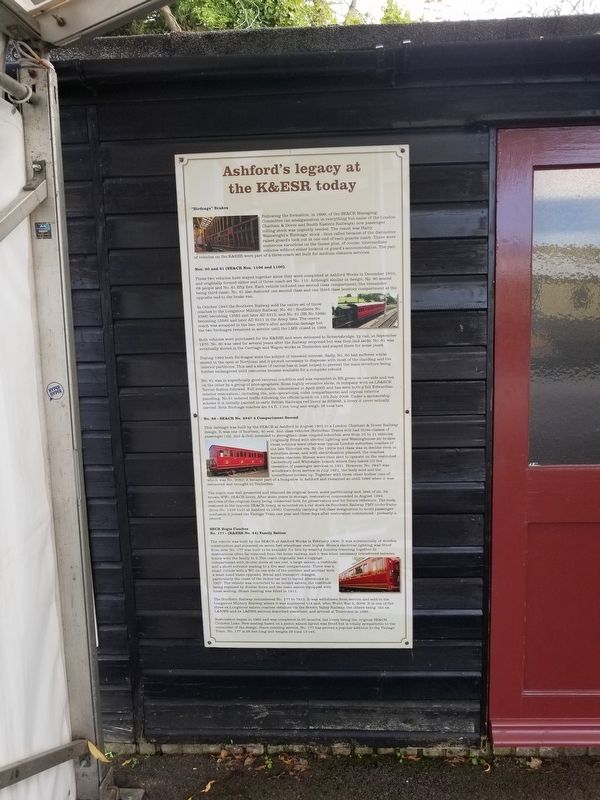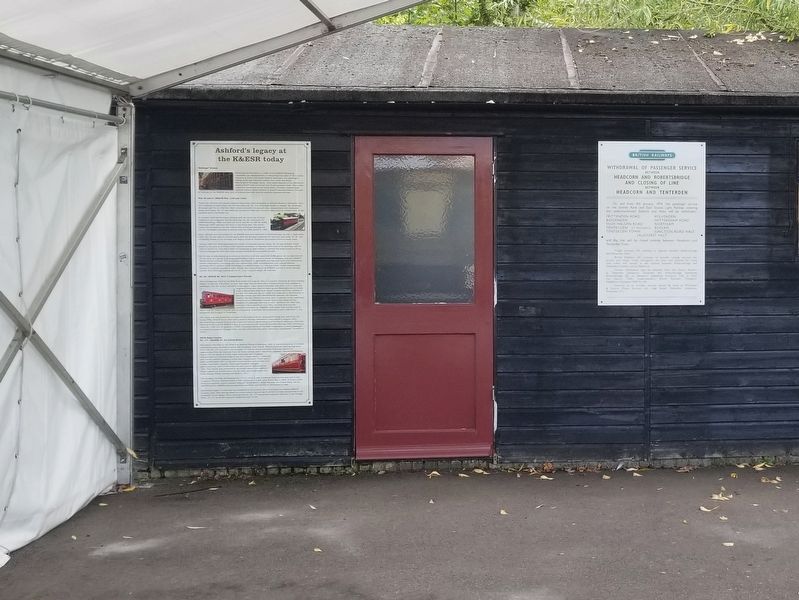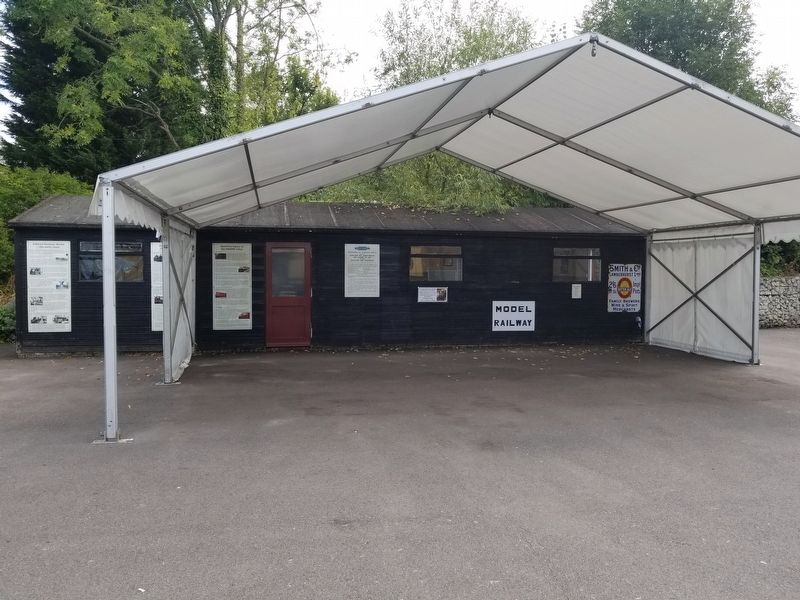Tenterden in Kent, England, United Kingdom — Northwestern Europe (the British Isles)
Ashford’s legacy at the K&ESR today
Following the formation, in 1899, of the SE&CR Managing Committee (an amalgamation in everything but name of the London Chatham & Dover and South Eastern Railways) new passenger rolling stock was urgently needed. The result was Harry Wainwright's ‘Birdcage' stock - thus called because of the distinctive raised guard's look out at one end of each guards coach. There were numerous variations on the theme plus, of course, intermediate vehicles without either lookout or guard's accommodation. The of vehicles on the K&ESR were part of a three-coach set built for medium distance services.
Nos. 60 and 61 (SE&CR Nos. 1106 and 1100).
These two vehicles have stayed together since they were completed at Ashford Works in December 1910, and originally formed either end of three coach set No. 113. Although similar in design, No. 60 seated 68 people and No. 61 fifty five. Each vehicle included one second class compartment (the remainder being third class). No. 61 also featured one second class and one third class lavatory compartment at the opposite end to the brake van.
In October 1943 the Southern Railway sold the entire set of three coaches to the Longmoor Military Railway; No. 60 (Southern No 3388) becoming 13583 and later AD 5312; and No. 61 (SR No 3368) becoming 13582 and later AD 5311 in the Army lists. The centre coach was scrapped in the late 1950's after accidental damage but the two birdcages remained in service until the LMR closed in 1969.
Both vehicles were purchased for the K&ESR and were delivered to Robertsbridge, by rail, in September 1970. No. 60 was used for several years after the Railway reopened but was then laid aside. No. 61 was stored in the Carriage and Wagon works at Tenterden and stayed there for some years.
During 1993 both Birdcages were the subject of renewed interest. Sadly, No. 60 had suffered whilst stored in the open at Northiam and it proved necessary to dispense with most of the cladding and the interior partitions. This and a sheet of canvas has at least helped to prevent the main structure being further endangered until resources became available for a complete rebuild.
No. 61 was in superficially good external condition and was repainted in BR green on one side and red on the other by a group of photographers. Some highly evocative shots, in company with ex-LB&SCR Terrier Sutton followed. Full restoration commenced in April 2005 and has seen both a full Edwardian interior restoration ( including the, non-operational, toilet compartments) and orginal exterior panelling. No.61 entered traffic following the official launch on 13th July 2008. Under a sponsorship scheme it is initially painted in early British Railways red livery as S3368S, a livery it never actually carried. Both Birdcage coaches are 54 ft. 1 ins. long and weigh 28 tons tare.
No. 88 - SE&CR No. 2947 4 Compartment Second
This carriage was built by the SE&CR at Ashford in August 1901 to a London Chatham & Dover Railway design. It was one of fourteen, 40 seat, 2nd class vehicles (Suburban Trains still had three classes of passenger (1st, 2nd & 3rd) intended to strengthen close coupled suburban sets from 10 to 11 vehicles. Originally fitted with electric lighting and Westinghouse air brakes these vehicles were otherwise typical London suburban coaches of the late Victorian era. By the 1920s 2nd class was in decline even in suburban areas, and with electrification planned, the coaches became obsolete. Eleven were then sent to operate on the restricted Canterbury and Whitstable branch where they lasted till the cessation of passenger services in 1931. However, No. 2947 was withdrawn from service in July 1921, the body sold and the underframe broken up. Together with three other bodies (one of which was No. 3062) it became part of a bungalow in Ashford and remained so until 1986 when it was recovered and brought to Tenterden.
The coach was well preserved and retained its original doors, some partitioning and, best of all, its brown WW1 SE& CR livery. After some years in storage, restoration commended in August 1994, sections of the original livery being conserved both for preservation and for future reference. The body, restored in the maroon SE&CR livery, is mounted on a cut down ex-Southern Railway PMV underframe (from No. 1228 built at Ashford in 1936). Currently carrying 3rd class designation to avoid passenger confusion it joined the Vintage Train one year and three days after restoration commenced - probably a record.
SECR Bogie Coaches
No. 177 - (K&ESR No. 84) Family Saloon
The vehicle was built by the SE&CR at Ashford Works in February 1900. It was substantially of wooden construction and mounted on seven feet wheelbase steel bogies. Stone's electrical lighting was fitted from new. No. 177 was built to be available for hire by wealthy families traveling together to destinations often far removed from the home railway, and it was when necessary transferred trains with the family in it.The coach originally had a luggage compartment with double doors at one end, a large saloon, a vestibule and a short corridor leading to a five seat compartment. There was a small cubicle with a WC on one side of the corridor and another with a wash hand basin opposite. Social and transport changes, particularly the onset of the motor car led to layout alterations in 1907. The vehicle was converted to an invalid saloon, the vestibule being replaced by double doors and the main saloon equipped with loose seating. Steam heating was fitted in 1911.
The Southern Railway renumbered No. 177 to 7913. It was withdrawn from service and sold to the Longmoor Military Railway where it was numbered 118 and, after World War 2, 3006. It is one of the three ex-Longmoor saloon coaches obtained via the Severn Valley Railway, the others being the ex-L&NWR and ex L&SWR saloons described elsewhere, and arrived at Tenterden in 1985.
Restoration began in 1992 and was completed in 20 months, the livery being the original SE&CR Crimson Lake. New seating based on a picnic saloon layout was fitted but is totally sympathetic to the remainder of the design. Since entering service, No. 177 has proved a popular addition to the Vintage Train. No. 177 is 38 feet long and weighs 28 tons 13 cwt.
Topics. This historical marker is listed in this topic list: Railroads & Streetcars. A significant historical month for this entry is February 1900.
Location. 51° 4.214′ N, 0° 41.148′ E. Marker is in Tenterden, England, in Kent. Marker can be reached from the intersection of Station Road and Rogersmead, on the right when traveling north. Located at Tenterden Town Station, Kent & East Sussex Railway. Touch for map. Marker is in this post office area: Tenterden, England TN30 6HE, United Kingdom. Touch for directions.
Other nearby markers. At least 8 other markers are within walking distance of this marker. Ashford Railway Works (here, next to this marker); a different marker also named Ashford’s legacy at the K&ESR today (here, next to this marker); Tenterden Yard Crane (within shouting distance of this marker); Tenterden Town The First Station Building (within shouting distance of this marker); Kent & East Sussex Railway (within shouting distance of this marker); Royal Visit (within shouting distance of this marker); Tenterden Town Signal Box (within shouting distance of this marker); Rye & Camber Coach Chassis (within shouting distance of this marker). Touch for a list and map of all markers in Tenterden.
Also see . . . Kent & East Sussex Railway. (Submitted on February 1, 2019, by Michael Herrick of Southbury, Connecticut.)
Credits. This page was last revised on January 27, 2022. It was originally submitted on February 1, 2019, by Michael Herrick of Southbury, Connecticut. This page has been viewed 108 times since then and 8 times this year. Photos: 1, 2, 3. submitted on February 1, 2019, by Michael Herrick of Southbury, Connecticut.


